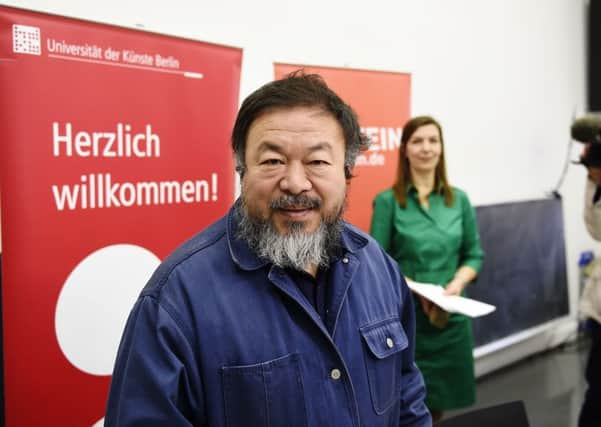Joe Wilson: Ai Weiwei’s art is none of Lego’s business


There are many things in life that you don’t feel you’ll ever need to do. I never expected, for example, to have a bad word to say about Lego. But this may be about to change, as the news hit this week that the Danish construction toy manufacturers have refused a bulk order for their bricks from the studio of Ai Weiwei. The Chinese artist has used Lego blocks before, creating portraits of famed political dissidents such as Nelson Mandela in an installation at the former site of Alcatraz prison in the San Francisco bay. Weiwei intends now to repeat the trick at Australia’s National Gallery of Victoria, but Lego rejected his request because, in their words, it “cannot approve the use of Legos for political works.”
Is it really up to Lego to “approve” what people do and do not make with their product? Weiwei has not asked for sponsorship from them; he has offered to pay for the bricks just like everyone else. Lego is assuming a responsibility that is not theirs. As a child, the appeal of their product was in the freedom it provided. When playing with Lego bricks, the only limit was your own imagination. It appears that this is now no longer the case; rather, the limit is a pre-approved list of the company’s preferred creations. This, of course, is impossible to enforce, and nobody would buy the product if they were expected only to build the rubbish spaceship on the box. To single Ai Weiwei out as an undesired customer seems to be distinctly unfair.
Advertisement
Hide AdAdvertisement
Hide AdLego has not become Big Brother panicking about “thoughtcriminals” and their toy boxes. This is a company merely protecting its own business interests. Sales of Lego have stalled in its biggest markets, Europe and the US, and as such it is making a concentrated effort to promote the product in China. Ai Weiwei is well known for his criticisms of the Chinese government and was even arrested by them in a crackdown on political activists in 2011. (His passport was only returned to him this year.) As Lego makes a move for the Chinese market, it’s clear that they view any association with Ai Weiwei as harmful. It is not the political message in his art that Lego fear, but the artist himself.
This hardly paints Lego in a better light. Instead of appearing to enforce a draconian ruling on the use of their product, it is merely a pathetic pandering to the ill-will of a draconian government. In doing so, the company has explicitly blocked a creative act, in contravention of what is surely the key aim of their product. Lego’s official slogan is “play on” after all – just not in this case.
Lego could have easily rejected Ai Weiwei’s order for their bricks on genuine moral and ethical grounds – he has a history of disrespect for the cultural sensitivities of his materials. For example, in his 1995 work, Dropping a Han Dynasty Urn, he did exactly that, smashing it to pieces. Two years later, he painted the Coca Cola logo over an urn from the Tang dynasty, which dates from somewhere circa 619–907 AD. Weiwei destroyed even more Chinese antiquity in the late 2000s, dipping potentially 7,000-year-old Neolithic pots in enamel paint for Painted Vases in 2009, and crushing them to dust for a piece in 2008. This was cultural vandalism and an unacceptable act of disregard for his nation’s heritage.
You could say that, as with Lego, ownership of the objects gave the artist the right to do with them as he pleased. But ownership of such antiquity comes with a duty of care. Each of those pots was part of the shared history of everyone in his country, and in terms of those from Neolithic times, civilisation itself. By destroying these objects, Ai Weiwei robbed people of a part of their past. Every effort should be made to preserve a nation’s heritag,e and if the artist was unwilling to accept this responsibility the urns should have been handed over to a museum, who would have. To deliberately destroy them was a disgrace, and no amount of artistic reasoning can excuse this.
Ai Weiwei has accused Lego of “censorship” in their refusal to provide him with their bricks, but he’s wrong. Lego can refuse to sell to him, but he can acquire the product through other channels and they are powerless to prevent him from creating his installation. He will acquire the bricks too, having set up collection points in cities around the world where people are readily rushing to defiantly donate theirs to his project. So against the wishes of Lego, whatever you make of them, Weiwei will “play on.” Interestingly, he once again will find himself with the collected histories of a group of people in his hands; bricks that people have played with since childhood, learned with and been inspired by. Bricks that may have helped forge brilliant creative and academic minds. This time, however, the artist has express permission to re-appropriate these objects in his work. Lego’s actions unwittingly will now provide him with a better, more thought-provoking artwork. I only hope that he will understand why.
• This is an edited article from I Think Of Icarus, a museum blog run by Glasgow-based writer Joe Wilson. http://ithinkoficarus.com/